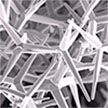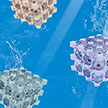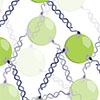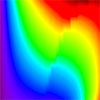Showing Spotlights 345 - 352 of 2784 in category All (newest first):
 Researchers have developed an antiviral dressing material with visible-light-activated sterilizing properties that enables physical and chemical protection against viral agents like Herpes simplex. They re-engineered a common additive agent found in sunscreen (zinc oxide) to be self-sterilizing within a non-woven fibrous mats for herpes virus treatment. The self-sterilizing function creates a 'green' associated oxidant hydrogen peroxide (hydrogen peroxide), capable of eliminating harmful bacteria and viruses.
Researchers have developed an antiviral dressing material with visible-light-activated sterilizing properties that enables physical and chemical protection against viral agents like Herpes simplex. They re-engineered a common additive agent found in sunscreen (zinc oxide) to be self-sterilizing within a non-woven fibrous mats for herpes virus treatment. The self-sterilizing function creates a 'green' associated oxidant hydrogen peroxide (hydrogen peroxide), capable of eliminating harmful bacteria and viruses.
Oct 12th, 2021
 An interdisciplinary approach that integrates optics, bioengineering, and nanotechnology has led to the fabrication of a living optical hydrogel fiber with many applications, including cancer models, physical force sensing, and covid detection, among others. This work represents a simple and low-cost approach to fabricating optical fibers made from biological materials. These fibers can be easily modified for specific applications and don't require sophisticated equipment to generate relevant information. This method could be used for many practical sensing and biological modeling applications.
An interdisciplinary approach that integrates optics, bioengineering, and nanotechnology has led to the fabrication of a living optical hydrogel fiber with many applications, including cancer models, physical force sensing, and covid detection, among others. This work represents a simple and low-cost approach to fabricating optical fibers made from biological materials. These fibers can be easily modified for specific applications and don't require sophisticated equipment to generate relevant information. This method could be used for many practical sensing and biological modeling applications.
Oct 11th, 2021
 Polymer dielectrics are widely used as an insulating material in advanced electronics and electric power systems that require operation at high temperatures and high breakdown conditions. The miniaturization and higher power of modern electronics generate lots of heat, which needs to be dissipated quickly to avoid device malfunction or breakdown. This increased heat also leads to the temperature rise of insulating materials, which gradually causes the loss of dielectric performance. To address this, researchers report a new strategy to achieve high thermal conductive electric insulator polyethylene with high dielectric constant and strength.
Polymer dielectrics are widely used as an insulating material in advanced electronics and electric power systems that require operation at high temperatures and high breakdown conditions. The miniaturization and higher power of modern electronics generate lots of heat, which needs to be dissipated quickly to avoid device malfunction or breakdown. This increased heat also leads to the temperature rise of insulating materials, which gradually causes the loss of dielectric performance. To address this, researchers report a new strategy to achieve high thermal conductive electric insulator polyethylene with high dielectric constant and strength.
Sep 30th, 2021
 Precise patterning of 2D materials is a route to computation and storage using 2D materials, which can deliver potentially better performance and much lower power consumption compared to the technology of today. Researchers now demonstrate an etching process that makes it possible to downsize nanostructures to the 10-20 nm range and obtain smooth edges, sharp corners, and feature sizes significantly below the resolution limit of electron beam lithography. The nanostructured 2D materials can be used themselves or as etch masks to pattern other nanomaterials.
Precise patterning of 2D materials is a route to computation and storage using 2D materials, which can deliver potentially better performance and much lower power consumption compared to the technology of today. Researchers now demonstrate an etching process that makes it possible to downsize nanostructures to the 10-20 nm range and obtain smooth edges, sharp corners, and feature sizes significantly below the resolution limit of electron beam lithography. The nanostructured 2D materials can be used themselves or as etch masks to pattern other nanomaterials.
Sep 4th, 2021
 Hydrogels are fascinating natural or synthetic polymer materials that exhibit very versatile chemistries and physical or biological properties. They are 3D networks of either physically or chemically crosslinked polymers that resemble organic tissues and that can hold large amounts of water within their interlocked molecular network. These soft, translucent materials swell or shrink in response to water absorption or desorption and can hold a large amount of water without losing their structural integrity.
Hydrogels are fascinating natural or synthetic polymer materials that exhibit very versatile chemistries and physical or biological properties. They are 3D networks of either physically or chemically crosslinked polymers that resemble organic tissues and that can hold large amounts of water within their interlocked molecular network. These soft, translucent materials swell or shrink in response to water absorption or desorption and can hold a large amount of water without losing their structural integrity.
Aug 30th, 2021
 In addition to the plethora of functions such as storage of genetic information and regulation of its expression, DNA and RNA are also highly programmable biomaterials. DNA can be utilized to design short complementary sequences to be used as the linkers which bring together and organize other biological and inorganic materials. Quantum dots are one such inorganic candidate. Researchers now utilized DNA for the precise assembly of QDs into larger three-dimensional scaffolds.
In addition to the plethora of functions such as storage of genetic information and regulation of its expression, DNA and RNA are also highly programmable biomaterials. DNA can be utilized to design short complementary sequences to be used as the linkers which bring together and organize other biological and inorganic materials. Quantum dots are one such inorganic candidate. Researchers now utilized DNA for the precise assembly of QDs into larger three-dimensional scaffolds.
Aug 18th, 2021
 Resistive-switching memory (RSM) is an emerging candidate for next-generation memory and computing devices, such as storage-class memory devices, multilevel memories and as a synapse in neuromorphic computing. A significant challenge in the global research efforts towards better energy technologies is efficient and accurate device modeling. Now, researchers have created a new modeling toolkit which can predict the current of a new type of memory with excellent accuracy.
Resistive-switching memory (RSM) is an emerging candidate for next-generation memory and computing devices, such as storage-class memory devices, multilevel memories and as a synapse in neuromorphic computing. A significant challenge in the global research efforts towards better energy technologies is efficient and accurate device modeling. Now, researchers have created a new modeling toolkit which can predict the current of a new type of memory with excellent accuracy.
Aug 11th, 2021
 Negative differential resistance (NDR), which describes a decrease in electrical current as the applied bias increases, has always been one of the hottest topics in solid-state electronic devices since L. Esaki first demonstrated this phenomenon in heavily-doped Ge p-n junctions in 1958. Researchers now report the modulation of a unique room-temperature NDR effect with high peak current in ambipolar black phosphorus transistors. The simplicity of this structure, combined with the recent progress in scalable production of BP films, makes the BP NDR devices promising for practical electronic applications.
Negative differential resistance (NDR), which describes a decrease in electrical current as the applied bias increases, has always been one of the hottest topics in solid-state electronic devices since L. Esaki first demonstrated this phenomenon in heavily-doped Ge p-n junctions in 1958. Researchers now report the modulation of a unique room-temperature NDR effect with high peak current in ambipolar black phosphorus transistors. The simplicity of this structure, combined with the recent progress in scalable production of BP films, makes the BP NDR devices promising for practical electronic applications.
Aug 10th, 2021
 Researchers have developed an antiviral dressing material with visible-light-activated sterilizing properties that enables physical and chemical protection against viral agents like Herpes simplex. They re-engineered a common additive agent found in sunscreen (zinc oxide) to be self-sterilizing within a non-woven fibrous mats for herpes virus treatment. The self-sterilizing function creates a 'green' associated oxidant hydrogen peroxide (hydrogen peroxide), capable of eliminating harmful bacteria and viruses.
Researchers have developed an antiviral dressing material with visible-light-activated sterilizing properties that enables physical and chemical protection against viral agents like Herpes simplex. They re-engineered a common additive agent found in sunscreen (zinc oxide) to be self-sterilizing within a non-woven fibrous mats for herpes virus treatment. The self-sterilizing function creates a 'green' associated oxidant hydrogen peroxide (hydrogen peroxide), capable of eliminating harmful bacteria and viruses.
 Subscribe to our Nanotechnology Spotlight feed
Subscribe to our Nanotechnology Spotlight feed





